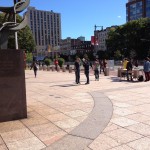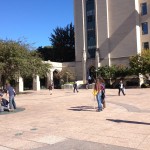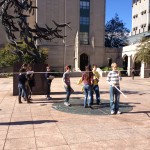So this week, they awarded the Nobel Prize in Physics. David Wineland from U. Colorado received the prize for his work in Quantum Optics. 17 years ago when I was applying to grad school for Photonics programs, I was actually decided between Colorado, Arizona, and B.U. That was just when Colorado was making a lot of its big optics discoveries. No regrets. Boston is more fun.
This week we have finished up Newton’s Third Law. After several probing questions about action-reaction, I posted the following question.
A robot pulls on a rope with a certain amount of tension T read by a scale.


Now two robots have a Tug-Of-War and pull on the rope from either side. What is the reading on the scale.

a) Zero
b) Equal to the original Tension T
c) Twice the original Tension T
This is a great question because the answer is not obvious. The students then tested their ideas using the LEGO NXT robots. Most houses used spring scales, but the ambitious Gryffindors went and connect Vernier Force Probes into NXT-Vernier adapters which allowed the robots to measure the tension in the string!
They wrote the above LabView code for this experiment. Way cool!
Today the students measured the height of Marsh Chapel. This was fun because there was so much variety in student methods. Some students used trigonometry. Some students used similar triangles. Some students used image analysis. Bravo for the students who helped each other out and worked together as a House to score lots of points. Boo-hiss on those who could not cooperate. They lost points.
But what surprised the students is how short March Chapel is. There is an optical illusion. Buildings are much taller than they seem. Michael and Tom use a 45 degree angle to find the height of the chapel. Which meant the chapel was only as tall as they were far away. It wasn’t as tall as they thought!




